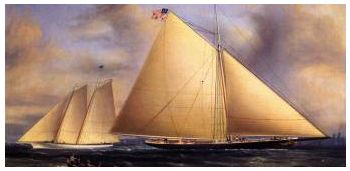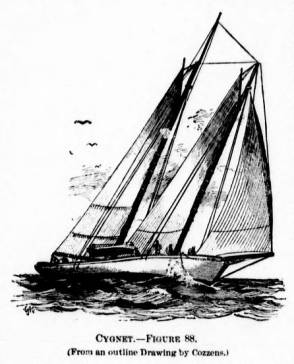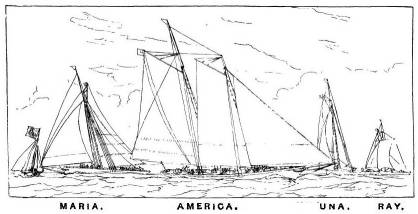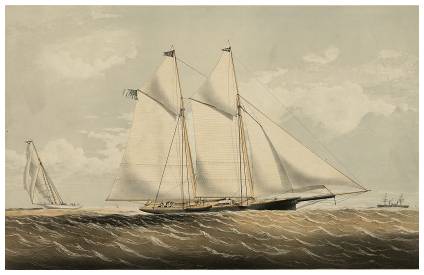Yves GARY Hits: 5736
Category: MARIA
 The Maria was designed in 1844 by Robert Livingston Stevens, working in conjunction with his brothers John C. and Edwin A., for whom the vessel was built by William Capes in his yard in Hoboken. She was launched in 1845, and began her racing career Oct. 6th, 1846, in the first amateur, or Corinthian, regatta of the New York Yacht Club, beating the fleet by an hour over a 40-mile course from the club-house in Hoboken, up the Hudson to Fort Washington, and down to the Narrows and back.
The Maria was designed in 1844 by Robert Livingston Stevens, working in conjunction with his brothers John C. and Edwin A., for whom the vessel was built by William Capes in his yard in Hoboken. She was launched in 1845, and began her racing career Oct. 6th, 1846, in the first amateur, or Corinthian, regatta of the New York Yacht Club, beating the fleet by an hour over a 40-mile course from the club-house in Hoboken, up the Hudson to Fort Washington, and down to the Narrows and back.
Her original lines are said to have been suggested by those of the North River sloop Eliza Ann, which, though not a yacht, showed great speed for those days. When launched the Maria was 92 feet long on deck. In 1850 she was lengthened by the addition of 18 feet to her bow, which made it long and sharp.
Maria made her first appearance in a race given under the auspices of the New York Yacht Club, October 6, 1846, the first Corinthian race held in this country. It took place over a course from the stake-boat off Fort Washington Point; thence to a stake-boat anchored in the Narrows, returning to the starting point, a distance of 40 miles. The sloops Lancet and Maria started in this race, as also the schooners Cygnet, La Coquille and Siren. There was a strong breeze blowing from southwest. Maria won easily, beating Siren 58 minutes, 15 seconds, actual time.
Maria next sailed a match race October 10, 1846, for $1,000 a side with the schooner Coquette, Maria being entered at 154 tons. The course was 25 miles to windward and return, and it was the first ocean race sailed. Maria started with double-reefed mainsail and bonnet off her jib, while Coquette carried all sail. Coquette won in 6 hours, 35 minutes, Maria covering the distance in 7 hours, 1minute.
Maria won the first prize in the second Annual Regatta of the New York Yacht Club, June 2, 1847, entered at 115 tons. Una appeared for the first time in this race, and won the second prize.
Maria entered at 118 tons in the third Annual Regatta, sailing against Siren and Cornelia, the last named yacht winning as, in a sudden gust of wind, Maria snapped her mast and her mainsail and boom went overboard.
In the fourth Annual Regatta of the New York Yacht Club, June, 1849, Maria entered at 119 tons, and sailed against Ultra, Cornelia and Siren. Cornelia came in first, but went on the wrong side of the western bank. Ultra won on time allowance, as Maria came in only 14 minutes ahead.
 In the fifth Annual Regatta, June, 1850, Maria entered again, this time at 126 tons, but was beaten on time allowance by both Ultra and Breeze.
In the fifth Annual Regatta, June, 1850, Maria entered again, this time at 126 tons, but was beaten on time allowance by both Ultra and Breeze.
On July 8th, 1850, Maria sailed against Ultra and Breeze. When off the False Hook the wind blew so fresh that the masthead of Maria was sprung and splintered, obliging her, when about half way between the Hook and the Light-ship to settle away her mainsail and return.
On August 10, 1854, Maria entered at 116 tons and sailed in the first yacht race held at Newport, Julia, Una, Gertrude, Irene, America (40 tons) and Ella Jane starting. The sloops were limited to mainsail and jib. Maria won, beating Ella Jane 45 minutes, 13 seconds, over the course of 45 miles. The wind was northeast and there was considerable sea.
 In 1862, at the Annual Regatta of the New York Yacht Club, Maria appeared as a schooner. She was altered for several reasons, among which was the fact that it had been found impossible to keep her stick in her: being of enormous beam and great initial stability, and her sail spread was something enormous for this times.
In 1862, at the Annual Regatta of the New York Yacht Club, Maria appeared as a schooner. She was altered for several reasons, among which was the fact that it had been found impossible to keep her stick in her: being of enormous beam and great initial stability, and her sail spread was something enormous for this times.
The Maria is said to have cost the Stevens brothers in all about $100,000. She was frequently altered and improved, and always represented advanced ideas. Owing to the size of her sail-spread she was dismasted several times. She was finally rigged as a schooner, and in the 6o's was sold, and renamed Maud.
She then engaged in the fruit trade between New York and Honduras ports, and in October 1870, when bound for New York with a cargo of cocoanuts, she was lost at sea, with all hands.
The Maria affords an interesting basis for comparative study of the progress made in racing sloops. Her memory should ever be kept green by American yachtsmen.

